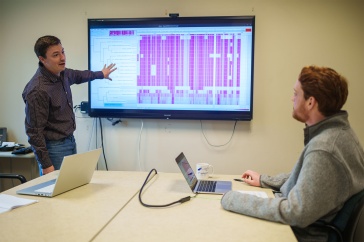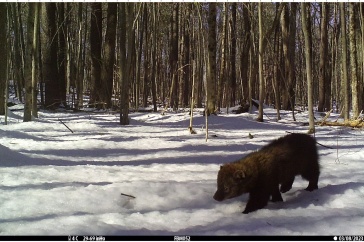Reported cases (confirmed and probable) of Lyme disease in Northern New England, 2000 & 2019
Source: Division of Public Health Services: Bureau of Infectious Disease Control
(Slide slider to the left to show 2019, to the right to show 2000)
Research Goals:
Use genomic sequencing and bioinformatics methods to comprehensively survey ticks on wildlife for both established and novel pathogens that may impact animal and human health. The data generated will establish a baseline for ongoing surveillance efforts.
Primary objectives:
- Conduct surveillance of ticks on wildlife across northern New England to assess known and unknown tick-borne pathogen threats.
- Evaluate and validate polymerase chain reaction (PCR) and sequencing techniques for tick pathogen screening.
- Provide baseline tick distribution and pathogen data to inform future epidemiological studies.
Tick-borne diseases have risen at an alarming rate in the past decade in New Hampshire, Maine and Vermont, posing serious threats to human, animal and environmental health and resulting in a need to improve surveillance and management of tick populations and the pathogens that they carry across these states. Thanks in part to a newly awarded grant from the U.S. Geological Survey, researchers at UNH’s NH Veterinary Diagnostic Lab (NHVDL) and the Hubbard Center for Genome Studies (HCGS) — along with partners at UNH’s Research Computing Center, the University of Vermont and the University of Maine — are working to establish baseline data on where different ticks are found, their numbers, and what pathogens they may carry across diverse vertebrate hosts.
The effort will inform future epidemiological studies on the spread of tick-transmitted diseases allow state agencies to target education and control efforts in high-risk areas to help mitigate the growing health threats posed by ticks and tick-borne illnesses to wildlife, pets, livestock and people in northern New England.
Our Changing Environment: Responding to Ticks & Tick-borne Illnesses
“In the past, tick-born illnesses — and even ticks themselves — were not a large concern in this region for clinical practices,” said David Needle, a senior veterinary pathologist and pathology section chief with the NHVDL and a clinical associate professor in the department of molecular, cellular and biomedical sciences.
“Today, veterinarians are engulfed in work related to the increased burden of ticks and tick-borne diseases which infect domesticated and wild animals in the region,” he added. “Tick prevention is now a vital part of veterinary care for companion animals and livestock, and vaccination against Lyme disease is amongst the most common vaccines administered to dogs.”
“Ultimately, the data we generate can help inform public health efforts, and it will serve as a key warning system to pet owners, livestock producers and the general populace —and just as importantly to the human and veterinary medicine practitioners responsible for safeguarding the health of these populations and their animals. ” ~ David Needle, senior veterinary pathologist, New Hampshire Veterinary Diagnostic Lab
The two-year project, which Needle is spearheading, will use genomic sequencing to screen ticks found on deer, moose, bears, furbearers (a group of mammals that includes racoons, skunk, fox, coyote, beaver and fishers), and birds and bats across northern New England for both known and new microbial pathogens.

Stephen Simpson (foreground) and Adane Nigatu, research scientists with the Hubbard Center for Genome Studies, work on the NovaSeq 6000 sequencing machine designed to rapidly read and identify cell information.
According to W. Kelley Thomas, director of the HCGS, researchers from HCGS and from the new Collaborative Core Wet Lab will extract DNA and RNA from individual ticks, as well as from their blood meal (the blood they take from host animals) and the microbes found in the ticks and within their blood meal.
“That DNA will be sequenced to understand the diversity of the ticks, their hosts and to identify known and unknown potential pathogens,” added Thomas, a professor of molecular, cellular and biomedical sciences at UNH.
Tick-borne Diseases on the Rise in Northern New England
Tick-borne diseases have been escalating in New Hampshire over the past two decades. According to the New Hampshire Department of Health and Human Services, cases of Lyme disease in the state rose from 262 (total) in 2002 to 1710 (confirmed and probable) in 2019. Reported cases of babesiosis (a microscopic tick-borne parasite) has also spiked in the U.S., rising from 1,126 in 2011 to 2,074 cases by 2015. Additionally, U.S. medical costs associated with tick-borne diseases are also substantial, with Lyme disease alone resulting in anywhere between $712 million and $1.3 billion in annual treatment costs, according to a 2015 report by Johns Hopkins.
Compounding these trends, new tick species such as the invasive lone star and Asian longhorned ticks have either recently been discovered in or have expanded their range closer to New Hampshire and northern New England in general. These exotic ticks can transmit deadly diseases like ehrlichiosis and pose serious threats to wildlife, pets, livestock and public health, which is why, according to Needle, more support for continual monitoring of tick populations and pathogens are critical to assess emerging risks, guide management policies and protect New Hampshire from the escalating impacts of ticks and tick-borne diseases.
New tick species, such as the invasive Asian longhorned (left) and lone star ticks have either recently been discovered in or have expanded their range closer to New Hampshire and northern New England in general. Photo credit: James Gathany—Centers for Disease Control.
“Ultimately, the data we generate can help inform public health efforts,” he added, “and it will serve as a key warning system to pet owners, livestock producers and the general populace—and just as importantly to the human and veterinary medicine practitioners responsible for safeguarding the health of these populations and their animals.”
This project is being conducted in collaboration with the Entomology Research Laboratory at University of Vermont, which is focused on studying fungal colonization in ticks to identify possible biocontrol methods, as well as the Tick Lab at the University of Maine Extension Diagnostic and Research Laboratory. The UNH Research Computing Center will also help in managing the data and making it public.
About the NH Veterinary Diagnostic Lab: NHVDL serves the state of New Hampshire by providing accessible, timely, and accurate diagnostic services for the New Hampshire Department of Agriculture, Markets & Food; New Hampshire Department of Health and Human Services; New Hampshire Fish and Game Department; state and local law enforcement agencies; veterinarians; farmers; and other relevant state, regional, and federal agencies. It is co-funded and co-managed by the New Hampshire Department of Agriculture, Markets & Food and the NH Agricultural Experiment Station and administered within the University of New Hampshire College of Life Sciences and Agriculture. The lab has served the state and the university since 1970, working at the junction of animal health, public health, environmental health, and economic health.
About the HGCS: The Hubbard Center for Genome Studies (HCGS) is a research center at the University of New Hampshire that is dedicated to advancing the field of genomics. Established in 2001, HCGS has grown to become one of the leading genomics research centers in the United States. The center conducts cutting-edge research in areas such as genome sequencing and bioinformatics, with a focus on understanding the function of genomes from across the spectrum of life. HCGS also provides training and education programs for students, researchers, and healthcare professionals, and works closely with industry partners to develop new genomics-based technologies and therapies.
-
Written By:
Nicholas Gosling '06 | COLSA/NH Agricultural Experiment Station | nicholas.gosling@unh.edu


















































